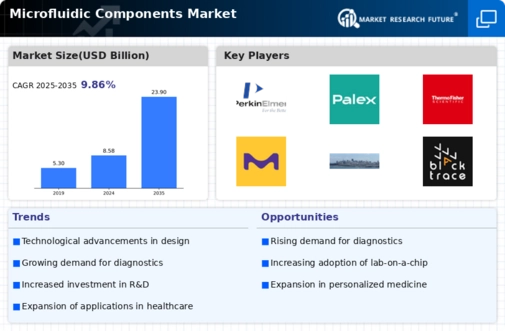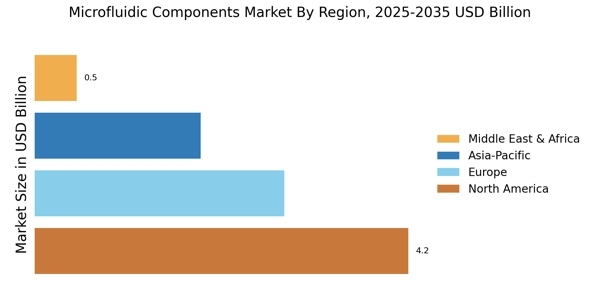Advancements in Material Science
The Microfluidic Components Market is benefiting from advancements in material science, which are enabling the development of more efficient and versatile microfluidic devices. Innovations in polymers, glass, and silicon materials are enhancing the performance and reliability of microfluidic components. These advancements allow for better fluid control, improved chemical compatibility, and increased durability of devices. As a result, manufacturers are able to produce microfluidic systems that meet the diverse needs of various applications, including biomedical, environmental, and chemical analysis. The material innovations are expected to drive market growth, with projections indicating a potential increase in market value by 10% annually over the next five years, as industries seek to leverage these new materials for enhanced functionality.
Increasing Adoption in Drug Development
The Microfluidic Components Market is experiencing a notable increase in adoption within the drug development sector. This trend is largely driven by the need for more efficient and cost-effective methods for drug formulation and testing. Microfluidic technologies enable researchers to conduct high-throughput screening and precise dosing, which can significantly reduce the time and resources required for drug development. According to recent estimates, the market for microfluidic devices in drug development is projected to reach USD 5 billion by 2026, reflecting a compound annual growth rate of approximately 15%. This growth is indicative of the industry's shift towards more innovative and streamlined processes, which are essential for meeting the demands of modern pharmaceuticals.
Growing Investment in Microfluidic Startups
The Microfluidic Components Market is experiencing a wave of investment in startups focused on microfluidic technologies. Venture capital and private equity firms are increasingly recognizing the potential of microfluidics in various applications, including healthcare, diagnostics, and environmental monitoring. This influx of capital is fostering innovation and accelerating the development of new microfluidic solutions. Recent reports indicate that investment in microfluidic startups has surged, with funding levels reaching USD 1 billion in the past year alone. This trend suggests a robust confidence in the future of microfluidic technologies, as investors seek to capitalize on the growing demand for efficient and effective solutions across multiple sectors.
Rising Demand for Point-of-Care Diagnostics
The Microfluidic Components Market is witnessing a surge in demand for point-of-care diagnostics, which are increasingly favored for their rapid and accurate results. The ability to perform tests at the site of patient care, rather than in centralized laboratories, is transforming the landscape of medical diagnostics. This shift is particularly relevant in areas such as infectious disease testing and chronic disease management. Market data suggests that the point-of-care testing segment is expected to grow at a rate of 12% annually, driven by advancements in microfluidic technologies that facilitate miniaturization and integration of complex assays. As healthcare providers seek to enhance patient outcomes through timely interventions, the relevance of microfluidic components in this domain becomes increasingly pronounced.
Integration of Microfluidics in Research and Development
The Microfluidic Components Market is significantly influenced by the integration of microfluidic technologies in research and development across various scientific fields. This integration allows for the manipulation of small fluid volumes, which is essential for experiments requiring precision and control. In academic and industrial laboratories, microfluidic devices are being utilized for applications ranging from genomics to materials science. The market for microfluidic devices in R&D is projected to grow substantially, with estimates indicating a potential market size of USD 3 billion by 2025. This growth is fueled by the increasing need for innovative solutions that can enhance experimental efficiency and reduce material waste, thereby aligning with broader sustainability goals.


















Leave a Comment